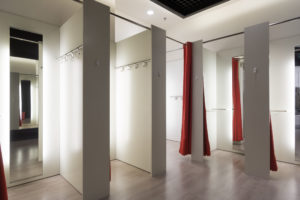Online clothing sales in the United States is growing faster than any other product in the e-commerce segment. This is due to improvements in retailer return policies, and because of advancements in online merchandising and the technologies available to consumers. One example of this is many online retailers offering what are known as “virtual dressing rooms,” where consumers can use augmented or virtual reality to “try on” garments they are interested in. This has led some to believe that virtual dressing rooms may make the in-store experience obsolete – but is this really the case?
How a Virtual Fitting Room Works
Leading virtual dressing room technologies allow customers to plug in specific body metrics (height, weight, hip width, etc.) to create a “robotic mannequin” which resembles the shape of their body. Consumers can then select articles of clothing they would like to try on and have their simulated mannequin show how the garment contours to their body from different angles, they can make sizes larger or smaller, choose different colors (if available), add shoes, accessories, and more.
Why Virtual Fitting Rooms Are Not the Answer
While they are certainly impressive at first glance, there are a number of reasons why virtual dressing rooms simply cannot replace brick-and-mortar fitting rooms:
The Technology Is Unfamiliar
Consumers may be unsure how to use the virtual dressing room technology or they may feel uncomfortable with it. This can be off-putting, leading customers away from making a purchase they otherwise might have made.
Consumers Don’t Want to Bother
Unless a consumer can simply upload an image of him or herself to the virtual dressing room or use 3D-body scanning, it’s unlikely that he or she will want to bother taking several measurements to create his or her own virtual mannequin. Not only is it time consuming, but it may be stressful or upsetting.
Nothing Beats Being Able to Feel the Garment When On
Virtual reality technology cannot show exactly how well a garment will compliment the unique contours of one’s body. As advanced as this technology is today, nothing perfectly mimics the experience of trying on a top or a pair of jeans and seeing and feeling the garment on in person.
Reduce Returns by Providing the Perfect Fitting Room Experience
Reducing the number of returned items is one of the leading reasons why retailers choose to incorporate virtual dressing rooms into their sales and marketing strategy. However, while the virtual dressing room can potentially reduce the number of returns from online consumers, they must still pay for the shipping and handling of returned items, take care of credit card processing fees, pay the repackaging expenses, and deal with restocking fees.
When a consumer has the opportunity to physically try on a garment, he or she can see firsthand whether or not they like the fit of the item, the color, and the style. If they choose not to buy it, a shop associate can easily restock the item right then and there.
Instead of investing in a virtual dressing room, retailers should invest in technology which will help them discover how they can be providing the best fitting room experience in their shop. By understanding how they can create the optimal fitting room environment in their store, retailers can substantially increase sales, improve customer retention, and streamline the entire fitting room process.

